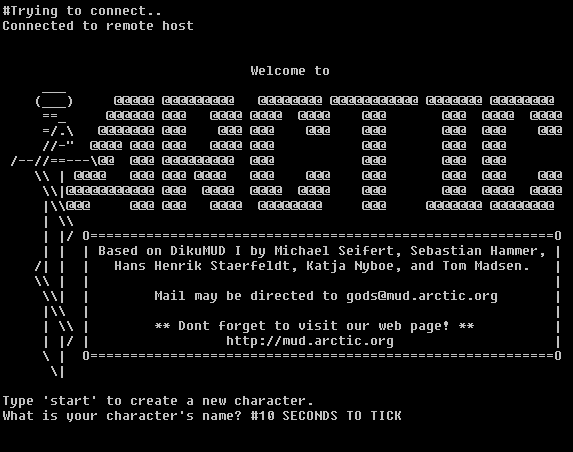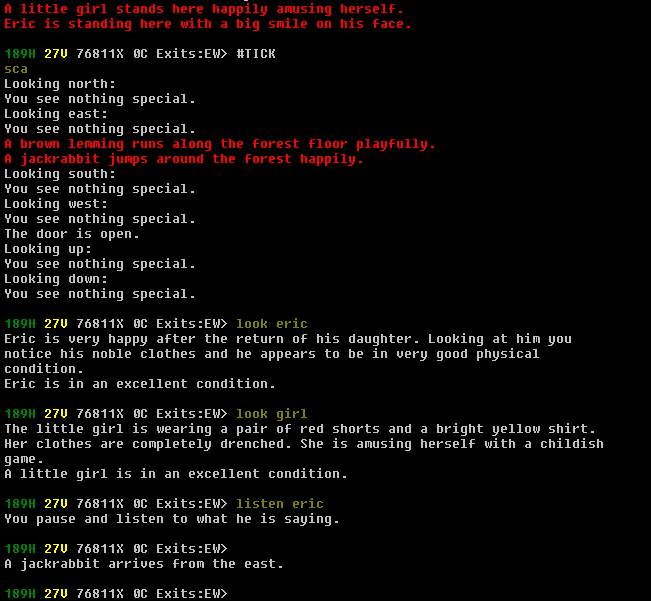
(Screenshot from the opening screen of Arctic MUD)
I have a confession to make. When I was in university for my first degree, I spent way too much time playing games, and not as much time as I should have on my studies. One of the games I played was called a multi-user dungeon (or MUD).
When I was asked recently by a colleague to help her find a typing game for her students, I was reminded of my experience playing MUDs. A MUD is a game written entirely in text, and their use predates the Internet itself. You enter the game through a specialized client, and type in commands, and read the results of your commands on the screen. Whole worlds can be created in muds. One of the MUDs I used to play had thousands of rooms players could move through, each of which had a description of the room. These descriptions were important, and because there was information in the room descriptions associated with mini-quests in the game, you had to read them thoroughly, and pay attention to details.
I took a typing course in high school, but none of the typing skills took. The course was incredibly boring, and my memories of it are of typing asdf asdf asdf over and over again. I did not learn typing from the typing course I took, I learned how to type as a result of spending hours and hours playing a MUD in school.
Every command I sent the mud had to be sent via the keyboard. There were no options to click on buttons to make the game work, you had to type. As a result, I had a strong incentive to learn how to type faster, because by typing faster, I made the game go faster. Typing faster gave me more control over the game, and this was amazingly empowering. Typing accurately was important too. The game moved fast, and if I typed something wrong, my character in the game died, or the game just sent back an annoying ‘Hunh?’ when it didn’t understand my command.
The next thing I realized is that the different parts of the mud (called zones) are each stories. When I move my character through the zone, it is like I am moving through a story, and controlling the action and pace of the story. This is part of the reason kids are so excited to play video games today; they have some control over the pace of the story, and the flow of the game. Today’s video games are excellent places for students to explore narratives, but they aren’t text narratives, and it is still important to understand text narratives.

(Screenshot from a zone on Arctic MUD called "Forest of Haven", created by Draknor)
The zones in a mud include things called mobs, which are non-player characters controlled by the computer. These mobs can be considered to be bit actors in the stories of a mud, and the players are the main characters. Imagine that instead of just reading about Tom Sawyer and how he tricked the other boys into whitewashing the fence, that you could join him in this mini-quest in the story, and interact with him and the other characters in the book. How would that change how you viewed the book?
I thought that muds could be a way that students could read, access, and see an interpretation of a story, but they could also create interpretations of stories. One of the advantages of muds has always been that the source code for many muds is free to download and modify, and that the resource required to run a mud are fairly minimal. The editing systems for most muds is reasonably archaic, but its not too complicated to create simple effects, certainly well within the reach of most students.
A group of university students created an online interpretation of Dante’s Inferno as an exercise for one of their literature classes. When the mud was active, you could literally walk around the layers of hell as described by Dante. Can you imagine what it must have felt like to have created Dante’s Inferno?
I see some interesting things one could do with a mud, but I need some feedback. Is this just a crazy idea?
Update: I just found out about Moose Crossing, which is a decades old project to do exactly what I am suggesting but with more control given to students than I had originally envisioned. Awesome.
Craig says:
I think it’s an amazing idea. If we had some kind of interactive, text-based story that my kids could interact with and engage in, that would be huge incentive for them to learn type faster. Do they need programming skills?
January 31, 2012 — 9:22 pm
David Wees says:
Actually, they don’t. I tested it out myself, and plan a future blog post (hopefully not too distant future) where I explain how to set it up yourself. If you have some programming skills, you can customize the mud further.
January 31, 2012 — 10:35 pm
Whitney Bizjak says:
I think the idea of MUD is a great way to teach typing skills to students in the first place. I never knew anything about this system until reading your blog post but it sounds quit interesting. With computers and technology being the future of many generations to come, typing is a going to become the new handwriting. I also took a typing class in highschool and all I can remember was playing those simple typing games over and over again. I learned most of my typing skills through social networking and blogging. It also seems quit interesting to me on having students create these muds because I believe, just by what you’ve explained to me, that these can be a great way to get the students to really use their imaginations and also forward their reading and typing skills.
January 31, 2012 — 10:51 pm
Alfonso Gonzalez says:
I think it’s a great idea. I love games and played a very similar game my first year of college.. My 8 year old daughter has taught herself how to type playing toon town and chatting with a school buddy. When I played with her she was typing faster than me! And she hen pecks! She was very motivated to get her thoughts and words out there quickly so she did. Games are so motivating and highly engaging. I’d love that for my students because my topics don’t motivate them all a lot of the time.
January 31, 2012 — 11:47 pm
John at TestSoup says:
I am constantly reminded of all the things I learned from playing video games as a kid. Everything from my sense of humor, my approach to problem solving (and the assumption that all problems can be solved), my typing speed, and my imagination have all been affected profoundly by video games.
The more you can bring these into the classroom, the better, in my opinion. Helping kids learn by doing stuff they already enjoy doing just makes sense!
February 1, 2012 — 11:48 am
Kaitlin Boatman says:
I do not think that it is a crazy idea at all! I think that students need to get excited about typing. I too was in a typical high school typing class, and I found it to be repetitive and boring. I think that if teachers could incorporate this into classrooms it would something different for the students and they would be more intrigued during the class, more willing to do their work.
February 12, 2012 — 4:51 pm